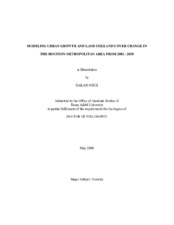| dc.description.abstract | The Houston-Galveston-Brazoria Consolidated Metropolitan Statistical Area (Houston CMSA) has experienced rapid population growth during the past decades and is the only major US metropolitan area with no zoning regulations. We use SLEUTH, a spatially explicit cellular automata model, to simulate future (2002-2030) urban growth in the Houston metropolitan area, one of the fastest growing metropolises in the United States during the past decades. The model is calibrated with historical data for the period 1974-2002 that are extracted from a time series of satellite images. The dataset consists of four historical urban extents (1974, 1984, 1992, 2002), two land use layers (1992, 2002), five transportation layers (1974, 1984, 1990, 2002, 2025), slope layer, hillshade layer, and excluded layer. Future growth patterns are predicted based on growth coefficients derived during the calibration phase. After calibrating the model successfully, the spatial pattern of urban growth of the Houston CMSA for the period from 2002 to 2030 is predicted. Within SLEUTH, growth in the Houston CMSA is predominately "organic" with most growth occurring along the urban/rural fringe. Projected increases in urban area from 2002 to 2030 parallel projected increases in population growth within the Houston CMSA. We design three specific scenarios to simulate the spatial consequences of urban growth under different environmental conditions. The first scenario is to simulate the unmanaged growth with no restrictions. The second scenario is to project the moderate growth trend by taking into consideration environmental protection, specifically for agricultural areas, forests and wetlands. The last scenario is to simulate the managed growth with maximum environmental protection. Adjusting the level of protection for different land cover types was found to markedly affect the land use changes in the Houston CMSA. Without any protection on resource lands, Houston CMSA is estimated to lose 2,000 km2 of forest land by 2030, about 600 km2 of agricultural land, and approximately 400 km2 of wetland. Approximately half of all resource land could be saved by the third scenario, managed growth with maximum protection. | en |


